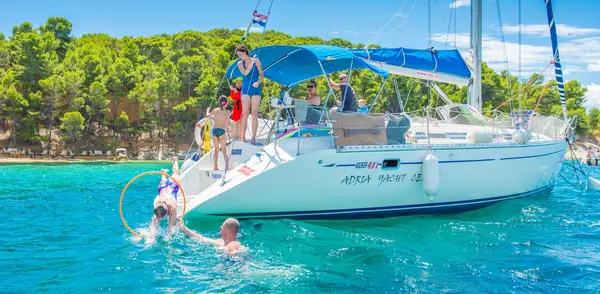2. Choose boats with a swim platform
If you still have small kids (or want to have easy access to the water), opt for a boat with a folding swim platform. When closed, it serves as a barrier and when opened out, it is close to the water’s surface so the children won’t be afraid to jump in and can easily dangle their feet in the water.

3. What is the right age?
Sailing has no upper or lower age limit. On a boat, you will have almost no problems with a baby, and older children can busy themselves. Regardless of the age of the child, it works best when they have companions of a similar age — for example when two families are travelling together. The ideal crew composition is one adult to one child, depending on the age of children.
A baby will feel comfortable in baby car seat (egg). Here you can relax under the bimini top and secure the seat using bungee cords, which can handle surprisingly large amounts of heel. Babies are used to rocking and therefore don’t suffer from seasickness.
Climbers and toddlers on board? We recommend using safety netting (lifeline netting) with children aged 1–2 years. This is a strip of netting placed on the railings around the perimeter of the boat, serving as a barrier. For an additional charge, you can order it fitted on a charter boat or just bring your own. Installation is not exactly easy, but the safety of your children is worth it. It is also important to have a deep (travel) cot that they can't climb out of and make sure to position it and secure it so that it cannot tip over.
2- to 3-year-olds are the most attention-intensive crew members. They move around themselves, but they lack balance. In addition to the safety netting, be sure to keep them close to you at all times. It is especially important to have one adult per child and the sooner you get them used to wearing life jackets, the better. Also, keep in mind that kids from 2 years of age must be registered in the crew list as a regular crew member.
YACHTING.COM TIP: For more handy tips on sailing with children (according to age — infants, toddlers, teenagers), check out our article on How to survive on a boat with kids.

4. How do you deal with seasickness?
Children of 3 years and older can get seasick. From our experience, if you don’t ask them how they are, they’ll be better off (otherwise, they can start to feel that they "should be feeling sick", and before long they will). It always helps to keep them occupied on board with an activity they can really get into and then they won’t notice the sway of the boat. If they do get seasick, put them in the shade, protect them from overheating or hypothermia, and give them plenty of liquids.
Sailors from 4 to 11 years of age are probably the ones you'll have the most fun with at sea. Generally, they can already swim, they're interested in everything, and they love experiences they can talk about. Time together on the boat will strengthen your bonds and they will get to experience you in a different setting. If you enjoy yachting, this is the age you can teach them about it in a fun way. They can learn to tie knots, work with ropes and drop anchor, and it's a great idea to have a paddleboard, an inflatable kayak and snorkelling gear.
Life jackets are an absolute must. Charter boats normally have them available and the size you need is determined by the weight of the child. If you sail (or plan to sail) more often at sea, it pays to invest in your own. It is important for the vest to fit your child well and that it is comfortable (it often has to be worn the whole day).
Teenagers... they're tough to deal with almost anywhere. However, if they have already been on a boat, they know what to do and how, and then they can take care of themselves. Plus, they can now join you as fully-fledged crew members.


